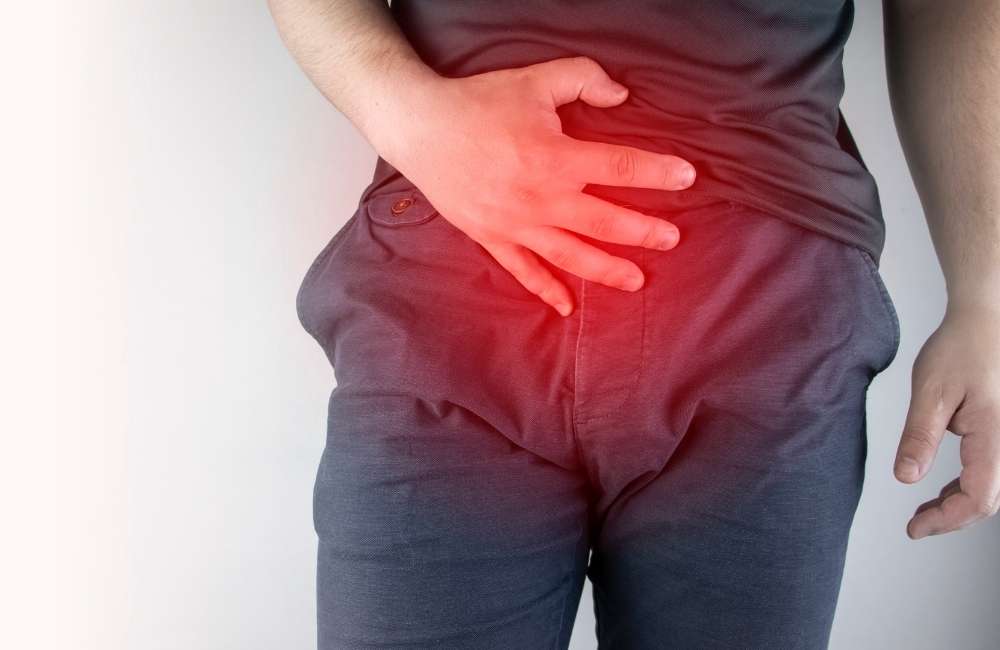Acute Urine Retention is a condition whereby a person cannot voluntarily pass urine despite having a full bladder. The urinary bladder is a storage reservoir for urine—a liquid containing waste products given off by the body and extracted from the bloodstream by the kidneys.
The major contractile muscle of the bladder is the detrusor. In man, the volume of urine it contains influences the voiding of the bladder. When 100–150 MLS of urine accumulate, the first sensations of a need to void are felt.
The feeling increases in intensity as more urine accumulates, and it becomes uncomfortable at a bladder volume of 350–400 MLS. When the walls of the bladder sense enough pressure, the detrusor muscle contracts, the bladder neck and opening to the urethra relax, and the contents of the bladder are emptied.
Normally the bladder empties. Impulses from the pelvic nerves mediate the sensations of bladder filling, painful distension, and the conscious need to urinate.
Voluntary urination requires coordination between muscles in the pelvic floor, the bladder, the urethra and the nerves innervating them. Any disruption along the pathway can cause urinary retention.
Even if this pathway is coordinating and working properly, mechanical obstruction along this pathway will also cause urinary retention.
What is Acute Urine Retention (AUR)?
Urinary retention is one of the most prevalent urological complaints resulting in patients presenting to the emergency department. This condition can be acute or chronic urine retention. It becomes acute when it is sudden and new onset of inability to voluntarily pass urine despite having a full bladder.
Patients with chronic retention can also enter acute retention either as an acute deterioration of the underlying pathology causing chronic retention or a new aetiology superimposed on a background chronic situation. This is called Acute-on-chronic urine retention.
Causes of Acute Urine Retention
Causes of urinary retention are numerous and can be classified as:
-
Obstructive
The most common cause of urinary retention in men is benign prostatic hyperplasia (BPH). While obstructive causes in women often involve the prolapse of the pelvic organs (cystocele, rectocele, uterine prolapse), pelvic mass (gynecologic malignancy, uterine fibroid, ovarian cyst) and retroverted impacted gravid uterus.
Other causes include abnormal narrowing of the urethral opening(meatal stenosis), paraphimosis-here the foreskin in uncircumcised males becomes trapped behind the glans penis obstructing urinary flow, penile constricting bands, phimosis- a condition where the penile foreskin is tight and cannot be pulled back over the head of the penis prostate cancer, aneurysmal dilation, bladder calculi (stones in the bladder), bladder neoplasm, faecal impaction, gastrointestinal or retroperitoneal malignancy/mass, urethral strictures, foreign bodies, stones, oedema etc.

-
Infections / Inflammatory
Prostatitis, cystitis, urethritis, vulvovaginitis, balanitis, a prostatic abscess
-
Pharmacologic
Medications with anticholinergic properties, such as tricyclic antidepressants (TCA) cause urinary retention by decreasing bladder detrusor muscle contraction.
-
Neurologic
Normal functioning of the bladder and lower urinary tract depends on a complex interaction between the brain, autonomic nervous system, and somatic nerves supplying the bladder and urethra. Interruption along these pathways can result in urinary retention of neurologic aetiology.
The neurogenic or neuropathic bladder is defined as any defective functioning of the bladder caused by impaired innervation. Up to 56 per cent of patients who have suffered a stroke will experience urinary retention, primarily because of detrusor hyporeflexia(conditions in which the bladder muscles are less responsive to stimuli).
-
Trauma
Penile trauma, fracture, or laceration, Disruption of the posterior urethra and bladder neck in pelvic trauma, post-operative complication, postpartum complications, urethral sphincter dysfunction (Fowler’s syndrome)
Symptoms / Clinical Presentation of Acute Urine Retention
Presentation is sudden onset or acute suprapubic pain and inability to void with a palpable massively distended urinary bladder. Patients with acute-on-chronic urine retention may present with minimal discomfort despite very large residual urine.
Please note that there is a condition called high-pressure urine retention. This refers to urinary retention with a very high bladder pressure with resultant failure of the anti-reflux mechanisms of the bladder.
Thus leading to a back pressure effect in the upper renal tract resulting in hydroureter (when the ureter gets bigger than normal due to a backup of urine) and hydronephrosis (a condition where one or both kidneys get swollen due to build-up of urine, usually happens when urine cannot drain out from the kidneys) which ultimately impairs the kidney clearance levels.
Repeated episodes in such a patient may present with features of chronic kidney disease(CKD).
Investigations for Acute Urine Retention
-
Post-void bedside pelvic ultrasound scan
This will show the volume of retained urine and help confirm the diagnosis. Patients with features of high-pressure retention will require an ultrasound assessment of their urinary tract to assess for the presence of associated hydronephrosis.
If this is confirmed, follow-up repeat imaging will be required in the subsequent weeks following treatment of the retention to ensure its resolution.
-
MRI spine
This evaluates for lumbosacral disk herniation, cauda equina syndrome, spinal tumours, spinal cord compression, and multiple sclerosis-all of which can lead to acute urine retention
-
Routine blood work
- Complete blood count
- C – reactive protein (CRP). CRP is a protein made by your liver and sent into your bloodstream in response to inflammation
- Electrolytes, urea and creatinine (EUCr) –assesses kidney function
- Fasting blood sugar(FBS). Undiagnosed or uncontrolled diabetes mellitus can cause a neurogenic bladder.
- Prostate-specific antigen (PSA). Elevated in prostate cancer; may be elevated in benign prostatic hyperplasia, prostatitis(infection of the prostate gland).
- Post-catheterization urine microscopy, culture and sensitivity m/c/s. The catheter specimen should be sent to the laboratory for an assessment
Treatment of Acute Urine Retention

Acute urinary retention should be managed by immediate and complete decompression of the bladder through catheterisation. Standard transurethral catheters are readily available and can usually be easily inserted.
If urethral catheterization is unsuccessful or contraindicated, the patient should be referred immediately to a physician trained in advanced catheterization techniques, such as the placement of a firm, angulated Coude catheter or a suprapubic catheter.
Hematuria, hypotension, and post-obstructive diuresis are potential complications of rapid decompression; however, there is no evidence that gradual bladder decompression will decrease these complications.
Rapid and complete emptying of the bladder is therefore recommended. For hospitalized patients requiring catheterization for 14 days or less, it’s been found that silver alloy-impregnated urethral catheters have been associated with decreased rates of UTI versus standard catheters
Conclusion
AUR is a commonly seen genitourinary emergency. It has many etiologies, including obstructive, neurogenic, pharmacologic, and extra urinary causes. Treatment is immediate bladder decompression by transurethral catheterization and treatment of the provoking aetiology.

